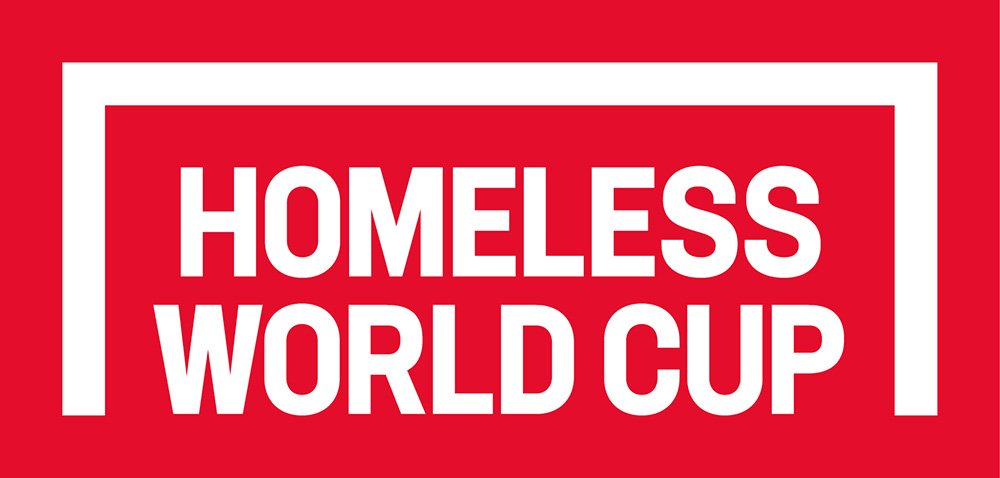Team behind the team
|Kjell-Egil Bogfjellmo Haug (right) and team Norway Image: Anita Milas
By Fiona Crawford
Among the least visible but most trusted contributors to the Homeless World Cup tournament are eight Scandinavian physiotherapy students and their university lecturers.
Operating as the team behind the teams, the physios are on hand to deal with everything from heatstroke to acute injuries and some more chronic conditions exacerbated by the length and intensity of tournament play.
Most of the care takes place quietly and privately in a tent adjacent to the pitches and in many ways only visible through the occasional glimpse of strapping tape that is fundamental to players’ ability to navigate the tournament.
|Nicolas Kjerulf (left) and team Denmark Image: Anita Milas
Fluge Petterson had some awareness of what to expect clinically coming into the Homeless World Cup, having worked on the national titles in his home country that preceded this tournament. Watching The Beautiful Game gave him a preview of what the tournament play would look like. There weren’t a lot of physios featured in the film, though, so that part of their experience is unique.
‘What you do is meet the players quite close for a short space of time,’ Norwegian student Hårvard Fluge Petterson explains. It’s an intense, intimate experience, and one that requires players to feel safe in the students’ hands. To provide such an environment, the students start with trying to be as approachable as possible. ‘We try to make it easy for them to come here ask for help, because it can be difficult for them to come here [to ask for that],’ Fluge Petterson says.
‘Some of the players have been to physios at home. Some don’t even know what to ask about. It’s quite joyful to give them knowledge on what happened, why it happened, help them in every way we can,’ Fluge Petterson explains.
That help can also involve difficult conversations with players requesting treatment and strapping to enable them to play on, but with the students at times having to recommend that the players don’t play.
‘They want to play, I get it. So that can be one of the biggest challenges,’ Fluge Petterson says. As he points out, sometimes pushing through on a minor injury inadvertently predisposes a player to a major one. ‘So that’s one of the most important jobs here, [conveying] when it’s not safe to play. That’s a difficult message to give, and to receive as well.’
|Image: Anita Milas
Part of the tournament courtesy of a longstanding relationship between the Homeless World Cup and Oslo- and Copenhagen-based universities, the eight final-year students spend the tournament providing expert care to the Homeless World Cup players (and sometimes, as needed, to the occasional volunteer).
The team comprises four students from Norway and four from Denmark, overseen by university tuentors and experienced Homeless World Cup hands Nicolas Kjerulf and Kjell-Egil Bogfjellmo Haug. The work experience program came about through the universities seeking alternative placement opportunities for their students in non-government organisations. With its social enterprise status and its unique, globally applicable model for using sport to enact social change, the Homeless World Cup fits that alternative placement bill.
The students have quickly determined a structure and a rhythm. Before the day starts, they see a wave of players seeking pre-game strapping. Throughout the day, other players are seeking pain relief, which can come in the form of massage and physical therapy and sometimes through the application of some cold spray. (‘Theoretically, [the spray] can dampen pain by replacing it with a stronger sensation,’ Kjerulf explains.)
In addition to the injuries that require treatments the weather is also a factor. Heatstroke was an issue in 2023 host location Sacramento, which reached more than 40 degrees Celsius many days. Wet weather the morning of the first day that delayed the Seoul tournament start did have the physios considering if they might see some injuries related to the water-slicked pitch surfaces.
The rain cleared and the day proved relatively uneventful, though. (While a chance for the students to apply their skills to help players is ultimately the goal, all going well their skills would ideally not need to be called on. Fluge Petterson agreed that the best-case scenario would be a comfortably busy week—one busy enough to provide meaningful and varied learning but one that also means players are able to play on.) What instead stood out (and continues to stand out) was players’ consistent appreciation. ‘I’m very glad of how friendly everyone is,’ Fluge Petterson says. ‘Like, thankful for the help.’
Donate to the Homeless World Cup to keep the ball rolling
Words: Fred Crawford
Images: Anita Milas



